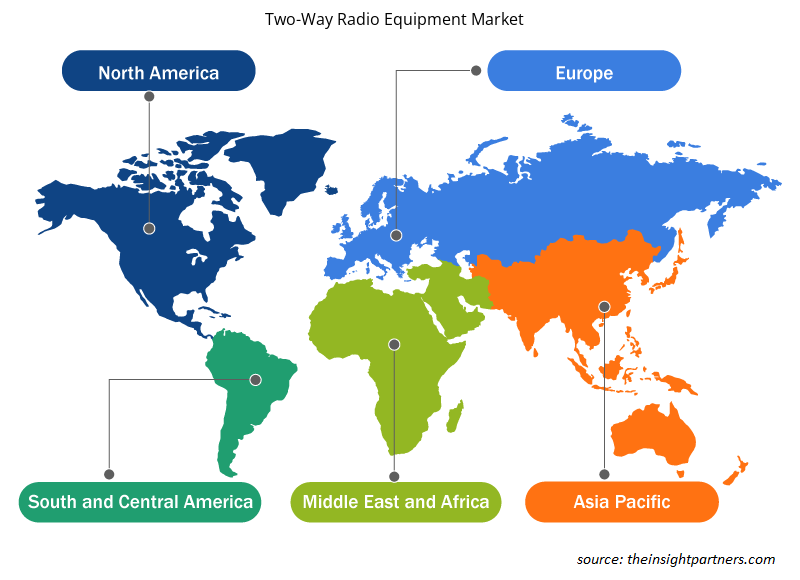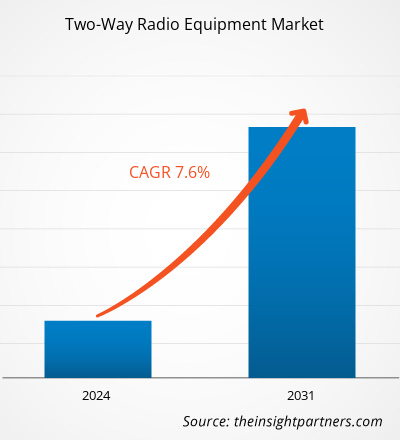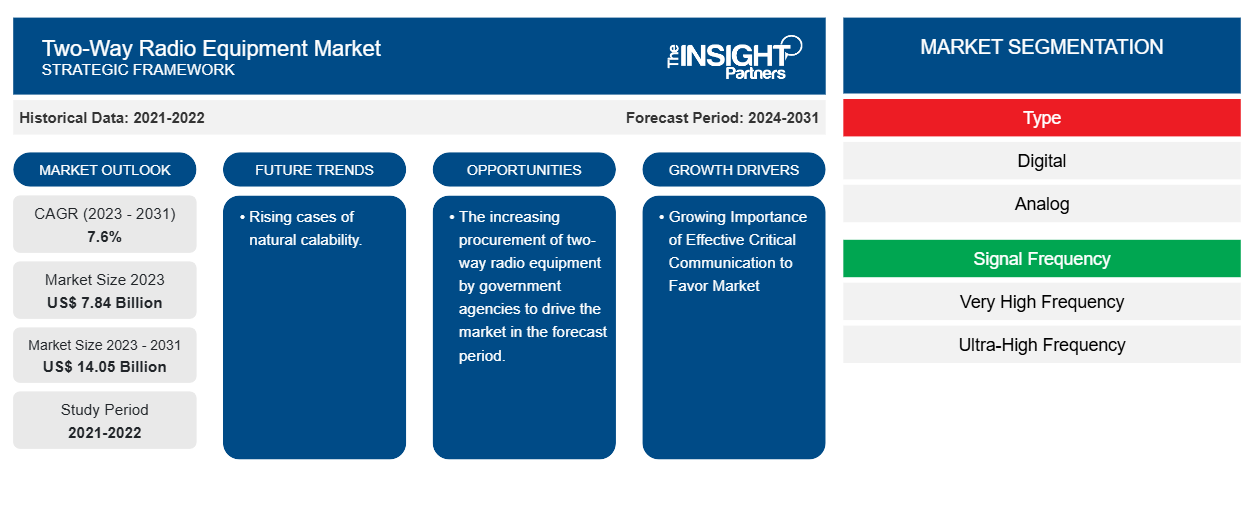Der Markt für Funkgeräte soll von 7,84 Milliarden US-Dollar im Jahr 2023 auf 14,05 Milliarden US-Dollar im Jahr 2031 anwachsen. Der Markt soll zwischen 2023 und 2031 eine durchschnittliche jährliche Wachstumsrate von 7,6 % verzeichnen. Die zunehmende Verbreitung digitaler Funkgeräte gegenüber analogen Geräten und die steigende Nachfrage nach Funkgeräten in der Sensorherstellung dürften die wichtigsten Treiber und Trends des Marktes sein.
Marktanalyse für Funkgeräte
Der Markt für Funkgeräte verzeichnet weltweit ein erhebliches Marktwachstum. Dieses Wachstum ist auf Faktoren wie die zunehmende Verbreitung digitaler Funkgeräte gegenüber analogen Geräten und die steigende Nachfrage nach Funkgeräten in der Sensorherstellung zurückzuführen. Darüber hinaus wird erwartet, dass die zunehmende Beschaffung von Funkgeräten durch Regierungsbehörden das Marktwachstum in den kommenden Jahren vorantreiben wird.
Marktübersicht für Funkgeräte
Ein Funkgerät ist ein Funktransceiver. Dieses Funkgerät kann sowohl kommunizieren als auch Funkwellen empfangen, was für die bidirektionale Sprachkommunikation von Person zu Person mit anderen Benutzern mit ähnlichen Funkgeräten genutzt wird, im Gegensatz zu einem Rundfunkempfänger, der nur Übertragungen empfängt. Funkgeräte verwenden normalerweise einen Halbduplex-Kommunikationskanal, der eine bidirektionale Kommunikation ermöglicht, allerdings mit der Einschränkung, dass immer nur ein Benutzer gleichzeitig senden kann.
Passen Sie diesen Bericht Ihren Anforderungen an
Sie erhalten kostenlose Anpassungen an jedem Bericht, einschließlich Teilen dieses Berichts oder einer Analyse auf Länderebene, eines Excel-Datenpakets sowie tolle Angebote und Rabatte für Start-ups und Universitäten.
-
Holen Sie sich die wichtigsten Markttrends aus diesem Bericht.Dieses KOSTENLOSE Beispiel umfasst eine Datenanalyse von Markttrends bis hin zu Schätzungen und Prognosen.
Treiber und Chancen auf dem Markt für Funkgeräte
Die Bedeutung einer effektiven, kritischen Kommunikation zur Förderung des Marktes nimmt zu.
Die wachsende Bedeutung effektiver kritischer Kommunikation treibt den Markt tatsächlich an. Die Funktechnologie hat sich von der traditionellen analogen Sprachkommunikation zu komplexen Systemen mit Bündelfunk- und Digitalfunktionen entwickelt, die Funktionen wie Gruppenanrufe, schnelle Einrichtung von Sprachanrufen, hochwertige Audioqualität und garantierten vorrangigen Zugriff für den Endbenutzer ermöglichen. Angesichts der zunehmenden Kriminalität, des Terrorismus und der Naturkatastrophen müssen die Branchen neue Technologien einführen, um schnelle und effektive Reaktionen in Echtzeit zu ermöglichen. Effektive Kommunikation ist für Einsatzkräfte der öffentlichen Sicherheit von entscheidender Bedeutung, die mit der Leitstelle in Verbindung bleiben und gleichzeitig bei der Reaktion auf Situationen Situationsinformationen in Echtzeit abrufen müssen.
Zunehmende Fälle natürlicher Katastrophen.
Die steigende Zahl von Naturkatastrophen wie Hurrikanen, Erdbeben, Waldbränden und Überschwemmungen hat die Nachfrage nach zuverlässigen Sprachsystemen deutlich erhöht und damit den Markt für Funkgeräte beflügelt. Im September 2023 erlebten die USA laut der National Oceanic and Atmospheric Administration 23 einzelne Wetter- und Klimakatastrophen, die jeweils Schäden in Höhe von mindestens 1 Milliarde US-Dollar verursachten. Während solcher Naturkatastrophen können traditionelle Kommunikationsinfrastrukturen wie Mobilfunknetze und Internetverbindungen aufgrund beschädigter Infrastruktur oder Überlastung oft gestört sein. In solchen Situationen verlassen sich Rettungskräfte, Regierungsbehörden und Hilfsorganisationen bei der kritischen Kommunikation in hohem Maße auf Funkgeräte, da diese robuste und belastbare Kommunikationsmöglichkeiten bieten.
Segmentierungsanalyse des Marktberichts für Funkgeräte
Wichtige Segmente, die zur Ableitung der Marktanalyse für Funkgeräte beigetragen haben, sind Typ, Signalfrequenz und Endverbrauchsbranche.
- Der Markt für Funkgeräte wird je nach Typ in digital und analog unterteilt. Das digitale Segment dürfte im Prognosezeitraum einen erheblichen Marktanteil halten.
- Basierend auf der Signalfrequenz ist der Markt für Funkgeräte in Hochfrequenz (VHF) und Ultrahochfrequenz (UHF) unterteilt. Das Hochfrequenzsegment (VHF) dürfte im Prognosezeitraum einen erheblichen Marktanteil halten.
- Nach Endverbrauchsbranche ist der Markt in die Branchen Regierung und öffentliche Sicherheit, Fertigung, Versorgungswirtschaft, Transport und Logistik, Bildung, Gastgewerbe und andere unterteilt. Das Segment Regierung und öffentliche Sicherheit dürfte im Prognosezeitraum einen erheblichen Marktanteil halten.
Marktanteilsanalyse für Funkgeräte nach geografischer Lage
Der geografische Umfang des Marktberichts für Funkgeräte ist hauptsächlich in fünf Regionen unterteilt: Nordamerika, Asien-Pazifik, Europa, Naher Osten und Afrika sowie Süd- und Mittelamerika.
Nordamerika dominiert den Markt für Funkgeräte. Die Einführung von Hochtechnologie in verschiedenen Branchen in Nordamerika hat das Wachstum des Marktes für Funkgeräte vorangetrieben. Faktoren wie die zunehmende Einführung digitaler Tools und hohe Technologieausgaben von Regierungsbehörden werden voraussichtlich das Wachstum des nordamerikanischen Marktes für Funkgeräte vorantreiben. Die zunehmende Einführung digitaler Funkgeräte gegenüber analogen Geräten und die steigende Nachfrage nach Funkgeräten bei der Herstellung von Sensoren. Darüber hinaus zwingt eine starke Betonung von Forschung und Entwicklung in den entwickelten Volkswirtschaften der USA und Kanadas die nordamerikanischen Akteure dazu, technologisch fortschrittliche Lösungen auf den Markt zu bringen. Darüber hinaus gibt es in den USA eine große Anzahl von Akteuren auf dem Markt für Funkgeräte, die sich zunehmend auf die Entwicklung innovativer Lösungen konzentrieren. All diese Faktoren tragen zum Wachstum des Marktes für Funkgeräte in der Region bei.
Regionale Einblicke in den Markt für Funkgeräte
Die regionalen Trends und Faktoren, die den Markt für Funkgeräte im Prognosezeitraum beeinflussen, wurden von den Analysten von Insight Partners ausführlich erläutert. In diesem Abschnitt werden auch die Marktsegmente und die Geografie für Funkgeräte in Nordamerika, Europa, im asiatisch-pazifischen Raum, im Nahen Osten und Afrika sowie in Süd- und Mittelamerika erörtert.

- Erhalten Sie regionale Daten zum Markt für Funkgeräte
Umfang des Marktberichts über Funkgeräte
| Berichtsattribut | Details |
|---|---|
| Marktgröße im Jahr 2023 | 7,84 Milliarden US-Dollar |
| Marktgröße bis 2031 | 14,05 Milliarden US-Dollar |
| Globale CAGR (2023 - 2031) | 7,6 % |
| Historische Daten | 2021-2022 |
| Prognosezeitraum | 2024–2031 |
| Abgedeckte Segmente |
Nach Typ
|
| Abgedeckte Regionen und Länder |
Nordamerika
|
| Marktführer und wichtige Unternehmensprofile |
|
Marktteilnehmerdichte für Funkgeräte: Auswirkungen auf die Geschäftsdynamik verstehen
Der Markt für Funkgeräte wächst rasant. Die Nachfrage der Endnutzer steigt aufgrund von Faktoren wie sich entwickelnden Verbraucherpräferenzen, technologischen Fortschritten und einem größeren Bewusstsein für die Vorteile des Produkts. Mit der steigenden Nachfrage erweitern Unternehmen ihr Angebot, entwickeln Innovationen, um die Bedürfnisse der Verbraucher zu erfüllen, und nutzen neue Trends, was das Marktwachstum weiter ankurbelt.
Die Marktteilnehmerdichte bezieht sich auf die Verteilung der Firmen oder Unternehmen, die in einem bestimmten Markt oder einer bestimmten Branche tätig sind. Sie gibt an, wie viele Wettbewerber (Marktteilnehmer) in einem bestimmten Marktraum im Verhältnis zu seiner Größe oder seinem gesamten Marktwert präsent sind.
Die wichtigsten auf dem Markt für Funkgeräte tätigen Unternehmen sind:
- BK Technologies Inc.
- Weitere Informationen zu Bearcom Group Inc.
- Hytera Communications Corporation Ltd
- Icom America Inc.
- Midland Radio Corporation
- Motorola Solutions Inc.
Haftungsausschluss : Die oben aufgeführten Unternehmen sind nicht in einer bestimmten Reihenfolge aufgeführt.

- Erhalten Sie einen Überblick über die wichtigsten Akteure auf dem Markt für Funkgeräte
Neuigkeiten und aktuelle Entwicklungen zum Markt für Funkgeräte
Der Markt für Funkgeräte wird durch die Erhebung qualitativer und quantitativer Daten nach Primär- und Sekundärforschung bewertet, die wichtige Unternehmensveröffentlichungen, Verbandsdaten und Datenbanken umfasst. Nachfolgend sind einige der Entwicklungen auf dem Markt für Funkgeräte aufgeführt:
- Hytera Communications, einer der weltweit führenden Anbieter professioneller Kommunikationstechnologien und -lösungen, hat kürzlich seine neueste eigensichere (IS) Funkgeräteserie herausgebracht, darunter das tragbare DMR-Funkgerät HP79XEx und das tragbare TETRA-Funkgerät PT890Ex. (Quelle: Hytera Communications Company Website, November 2023)
- Motorola Solutions hat die Markteinführung des MOTOTRBO R7 in Europa, dem Nahen Osten und Afrika angekündigt. Das neue digitale Funkgerät bietet erweiterte Audiofunktionen und ein schlankes, robustes Design, um Teams in lauten, rauen und dynamischen Umgebungen zu verbinden. (Quelle: Motorola Solutions Company Website, April 2022)
Marktbericht zu Funkgeräten – Umfang und Ergebnisse
Der Bericht „Marktgröße und Prognose für Funkgeräte (2021–2031)“ bietet eine detaillierte Analyse des Marktes, die die folgenden Bereiche abdeckt:
- Marktgröße und Prognose für Funkgeräte auf globaler, regionaler und Länderebene für alle wichtigen Marktsegmente, die im Rahmen des Berichts abgedeckt sind
- Markttrends für Funkgeräte sowie Marktdynamik wie Treiber, Einschränkungen und wichtige Chancen
- Detaillierte PEST/Porters Five Forces- und SWOT-Analyse
- Marktanalyse für Funkgeräte mit wichtigen Markttrends, globalen und regionalen Rahmenbedingungen, wichtigen Akteuren, Vorschriften und aktuellen Marktentwicklungen
- Branchenlandschaft und Wettbewerbsanalyse, die die Marktkonzentration, Heatmap-Analyse, prominente Akteure und aktuelle Entwicklungen auf dem Markt für Funkgeräte umfasst
- Detaillierte Firmenprofile
- Historische Analyse (2 Jahre), Basisjahr, Prognose (7 Jahre) mit CAGR
- PEST- und SWOT-Analyse
- Marktgröße Wert/Volumen – Global, Regional, Land
- Branchen- und Wettbewerbslandschaft
- Excel-Datensatz
Aktuelle Berichte
Verwandte Berichte
Erfahrungsberichte
Grund zum Kauf
- Fundierte Entscheidungsfindung
- Marktdynamik verstehen
- Wettbewerbsanalyse
- Kundeneinblicke
- Marktprognosen
- Risikominimierung
- Strategische Planung
- Investitionsbegründung
- Identifizierung neuer Märkte
- Verbesserung von Marketingstrategien
- Steigerung der Betriebseffizienz
- Anpassung an regulatorische Trends























 Kostenlose Probe anfordern für - Markt für Funkgeräte
Kostenlose Probe anfordern für - Markt für Funkgeräte